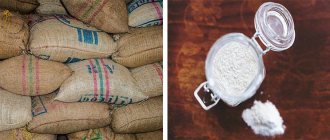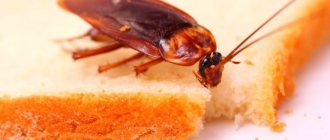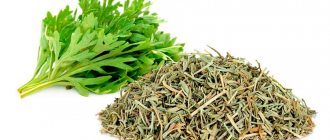Why do bugs appear in cereals, how to get rid of pests and which cereals are most susceptible to their influence? First of all, you need to understand that bugs only appear where there is constant access to food. Insects are attracted to loose materials not only in open containers and bags, but also when scattered on shelves and in cabinets.
Cereals and pasta are a favorite treat not only for bugs, but also for food moths. Insects also actively eat cereals, crackers, dried fruits, bread; they can be found in spices and food concentrates.
What bugs are found in the kitchen and how do they get there?
It’s not enough to discover that there are bugs in flour and cereals, damaging products with lightning speed. To choose effective pest control products, you need to clearly know what type they belong to. There are several main types of bugs that damage bulk products:
- bread grinder;
- flour bug;
- red mucous eater;
- food moth.
Bread grinders are miniature light brown bugs that can fly; they most often settle in cereals; they enjoy baked goods, old medicinal herbs, as well as tea and coffee with great pleasure. They enter the apartment with contaminated store products, as well as animal feed.
Flour bugs settle in flour more often than in any other product; they can often be found in bags of starch. Insects simply penetrate boxes in the kitchen with bulk products, including packages of rye, rice flour, rolled oats and semolina. Infrequently, you can see pests in dried fruits, rice or buckwheat.
The peculiarity of insects is the ability to reproduce quickly. Female beetles camouflage their oviposition in crevices of furniture in the kitchen, in cereals, flour, and on cabinet shelves. A new generation of pests quickly spreads throughout the home in search of food sources.
The red common mucoed is no more than 2.5 mm long. It most often enters the premises together with low-quality animal feed. The pest’s favorite food is cereals, grains, flour with an expired shelf life and a moisture content of no more than 15%. In order for the red flour beetle to stop spoiling food and breeding in the kitchen, it is enough to block access to food sources.
The food moth infests in buckwheat, rolled oats, semolina, rice, flour. A mature individual visually resembles a silver butterfly and reaches a length of 10 cm. Its appearance in the kitchen is associated with violation of food storage rules; in addition, the insect enters the house through ventilation holes and open windows.
In addition to the fact that insects are found in semolina, millet and other cereals, in some cases tea and cocoa, dried fruits, and pasta are also infected.
It is not difficult to identify pests in products - they leave behind a thin web woven from small yellow worms.
How to properly store dried apricots at home
You can store dried apricots at home, following general recommendations.
First of all, choose a suitable glass container with a tight-fitting lid. The vacuum effect will prevent oxygen from entering the container, which will extend the shelf life of dried fruits and protect them from being impregnated with foreign odors. To protect the product from pests, place an orange peel, a sprig of mint or lavender in a glass jar.
For storage, select only whole and firm fruits. Such dried fruits retain their taste and beneficial properties longer, as well as their color and original shape.
Optimal conditions and rules for storing dried apricots:
- temperature +10…15 ℃;
- humidity up to 70%;
- absolute protection from direct sunlight;
- remoteness from heating devices and sources of moisture (windows, sinks, etc.).
Dried apricots should not be stored together with other dried fruits (raisins, prunes, dates, figs, etc.), otherwise this will lead to mixing of their smells and tastes, which will not have the best effect on the quality of the product.
Selecting a Storage Capacity
To extend the shelf life of dried apricots, it is important to choose the right container. Do not use linen bags for dried fruits, as they allow moisture to pass through easily, causing the product to quickly deteriorate.
Do not use metal containers to store such supplies to avoid oxidation and loss of taste.
Polyethylene is also not the best option for storage. In such conditions, dried apricots will quickly become moldy and become unusable. In addition, pests will easily gnaw through polyethylene, smelling the sweet aroma. The bags can only be used when storing dried apricots in the freezer.
The best option for storing dried apricots is a glass container with a tight-fitting lid. In such a container, dried fruits retain their taste and benefits for quite a long time.
The ideal container for dry apricots is a glass jar with a tight-fitting lid. Such storage organization will protect dried fruits from mold and pests.For short-term storage, you can use a wooden or cardboard box, as well as ceramic dishes.
Choosing a place to store dried apricots
An important step in organizing dried apricot storage is choosing a location. In a city apartment, it is extremely difficult to find a suitable location where there will be the required temperature and humidity. However, experts identify several of the most suitable places: pantry, refrigerator and freezer. Let's take a closer look at each of the accommodation options.
You can store dried apricots in the pantry or in a kitchen cabinet. Use a wooden or cardboard box as a container. A hermetically sealed container will also work, but be prepared for the fact that with such storage, the dried apricot will eventually become covered with a white coating and lose its taste and beneficial properties.
Room conditions are not suitable for long-term storage of the product, since dried fruits can harbor bugs and other insects. But for dried apricots this option is generally unacceptable.
You can store dried apricots at room temperature using wooden or cardboard boxes as packaging. It is better to store such blanks in a pantry where the humidity is low and where ultraviolet rays do not reach
You can store dried apricots in the refrigerator. To do this, use a plastic or glass container. Store dried apricots in the door or on the middle shelves of the refrigerator away from other foods.
The freezer will help maximize the shelf life of the product. Under such conditions, dried apricots retain their taste and beneficial qualities for 12-18 months.
Before using frozen dried fruit, leave it at room temperature for 30-60 minutes to defrost.
To freeze dried fruit, follow these simple steps:
- Sort through the apricots, removing spoiled or damaged fruits.
- Place produce in a freezer bag or airtight plastic container.
- Place the preparation in the freezer drawer and store until needed. Avoid the proximity of dried fruits to meat and fish products.
You can preserve dried apricots at home by ensuring optimal temperature and humidity, as well as choosing the right container and place.
You can get information on how to store other types of dried fruits at home from this article.
Preventive measures: how to prevent infection?
To prevent insects in cereals from complicating your life by requiring a number of operations to destroy them, you can follow simple recommendations regarding the prevention of their appearance. These include:
- Warm up the purchased cereals in the oven at low temperature for half an hour.
- Freezing bulk products in the freezer for 24 hours (use dry, ventilated packaging).
- Dried fruits are treated with boiling water, followed by washing and storing exclusively in the refrigerator.
- Thorough inspection of purchased products (including vacuum packaging) with disposal of cereals and flour with signs of contamination.
Bulk materials should be stored in perforated polyethylene or closed glass containers. As an alternative, metal boxes and ecological bags made of natural linen are suitable.
One of the reasons why bugs appear in flour and cereals is failure to comply with the shelf life of products. To avoid creating conditions favorable for pests, it is worth buying cereals and other bulk products, as well as dried fruits, coffee and tea with a minimum supply.
It is believed that rice, semolina, flour and buckwheat can be stored for no more than six months; oatmeal and millet can be stored for no more than 4 months due to their high fat content.
The record holder for shelf life is polished rice. Many varieties become even better after several years of storage, acquiring additional taste.
If you still cannot avoid contamination of food in the kitchen, you can get rid of bugs in cereals, flour and spices in several ways.
Shelf life of dried fruits
Dried fruits can be stored for the longest possible time at low temperatures down to +10 degrees. These are refrigerator conditions. In kitchen cabinets and pantries the parameters are much higher. On average 18-24 degrees above zero. Consequently, shelf life is significantly reduced.
| Name | Shelf life at +2-10, in months | Shelf life at +18-24, in months |
| Raisins, cranberries, pears, apples | 18 | 6 |
| Dried apricots, prunes | 12 | 3 |
| Figs, dried mango, dates, banana chips | 10 | 3 |
| Rose hip | 24 | 12 |
| Cherries, dried cranberries | 18 | 12 |
To preserve the product for more than a year, we recommend storing it in the freezer. Only with this method some of the beneficial substances are lost. Also, do not defrost it repeatedly and then put it back into the chamber. Reliable packaging is also required.
You cannot store steamed, soaked, washed dried fruits. They are saturated with moisture, and putrefactive processes will begin inside over time.
It is also important to check inventory periodically. Damaged, darkened, questionable specimens should be removed
The presence of moldy dried fruits in the total mass threatens rapid spoilage of the entire quantity.
Previous Finished productsHow and how long to store boiled rice Next Finished productsRules and conditions for storing churchkhela
Thermal fighting - what effect does it give?
If there are bugs in the cereal, you can try to remove them by raising the temperature to +50 degrees Celsius. We are talking about treating containers with pests with boiling water or steam. The method is especially effective for removing pests in hard-to-reach places.
To free cereals and other bulk products from insects, you can dry them in the oven at temperatures up to 70 degrees for half an hour, or achieve the result by placing contaminated products in the freezer. Most bugs die at a temperature of -15 degrees Celsius.
After destroying the larvae and bugs from the kitchen cabinets and shelves, it is important not to forget to treat the surfaces, as well as all existing cereals, nuts, and beans. As a result of this treatment, it will be possible to get rid of the remaining insects that will simply float to the surface. However, given that products contaminated with insects are unfit for consumption, it is easier to get rid of them by replenishing supplies with fresh cereals and flour.
We systematically check stocks
Very often, homemade dried fruits contain pests and mold, so check your supplies from time to time. For convenience, keep such treats in a transparent container so that you can immediately notice any changes in the dried fruits.
If you suddenly find voracious insects or signs of their vital activity in dried fruits, immediately get down to business: spread the fruits in one layer on a baking sheet and fry in the oven at the maximum permissible temperature for drying 75° C. In winter, when frost is expected to be no lower than -15° C, you can take the infected dried fruits out into the fresh air, and in warm weather keep them at home in the refrigerator in the freezer. True, when you bring frozen fruits into a warm room, you will have to wait until the condensation evaporates from them, and only then put them in a clean container.
In homemade dried fruits, especially if they are apples, if stored improperly, excess moisture also accumulates - the cause of mold and premature spoilage of the product. In this case, immediately fry the damp apples and berries in the manner described above.
Chemicals in pest control
If there are bugs in the cereal, what should you do when the previous methods above do not give the desired effect? In such cases, it makes sense to use chemicals. The active drugs are Karbafos and Antizhuk. The second has a universal effect, helping to cope not only with kitchen bugs, but also with wood bugs that damage furniture, windows, laminate and parquet. The drug must be used with extreme caution, following the instructions.
Another remedy against pests, Rogneda, is a powerful antiseptic that allows you to dispose of a number of domestic insects, including mucous beetles, weevils, cockroaches and ants.
You can also remove bugs from the kitchen using the drug “Lovin Fire Protection”, which allows you to achieve a quick effect. The product has a high level of toxicity and is used when there are no animals or children at home.
External characteristics
If you have observed repeated appearances of butterflies over the course of three weeks, this is evidence that the infestation is quite serious and it is necessary to immediately take steps to eliminate the insects.
Read also: Permanent eyelid makeup
The winged moth is no longer capable of causing any harm, since their oral organ is reduced upon reaching sexual maturity. Parasites are their larvae, which, having powerful jaws, feed quite intensively and accumulate energy reserves so that upon reaching the adult stage they have the opportunity to reproduce.
Interesting fact! The absence of a proboscis is due to the fact that, upon reaching sexual maturity, the moth loses not only the ability to feed, but also to digest food. Therefore, they simply do not need this organ.
The caterpillar's head is brown. As a rule, infestation of dried fruits and vegetables with this type of moth will be indicated by small, neat nests and a thin cobweb around them. The larva will be inside the nest.
Working folk methods: which ones to choose?
Those who consider chemicals too dangerous and the disposal and destruction of insects by lowering or raising temperatures are not so effective should try to solve the problem with the help of folk remedies. Recipes for some of them are below:
- Table vinegar. All surfaces infected with the bug are treated with a vinegar-based water solution, along with the simultaneous disposal of cereals and flour damaged by pests.
- Bay leaf, pepper, garlic, sulfur. All of these are products whose smell is feared not only by flour bugs (the photo below will prevent you from making mistakes in identifying pests), but by other types of insects.
- Antiseptics of natural origin - chamomile or calendula can also repel pests.
An interesting option that allows you to forget, if not forever, then for a long time, what bugs in cereals are (a photo will help you correctly identify the type of each) is a trap based on boric acid.
Bait works on a simple principle: insects are attracted to the bait. Hungry bugs try a poisoned treat, become infected with toxins and poison the rest of the colony.
To prepare the bait, boric acid is mixed in a container with powdered sugar, semolina, honey, and syrup. Treats will only attract pests if they are fresh. It is recommended to use traps when children and pets are not at home, placing them in insect habitats.
The problem of the appearance of beetles in cereals is relevant. This is due to an unscrupulous attitude towards the saving conditions of producers, since most insects end up in cereals when packaged in factories.
Destruction of moths
Methods of killing moths
The moth is not distinguished by its quick reaction or strong flight abilities. It's easy to slam him. But there is no guarantee that this is the only or last butterfly in the room, so you should play it safe and use effective moth repellents in the apartment and in the kitchen in particular.
- Sticky tapes are hung around the kitchen, anti-moth tablets and special traps are used in cabinets.
- Among the folk remedies, herbs such as lavender, peppermint, chamomile, and geranium will help repel the pest. These plants repel moths with their scent. Orange peels and garlic are also excellent repellents.
- Ventilating the kitchen for 20 minutes every evening during cold periods reduces the activity of moths and creates unfavorable living conditions for them.
- In case of severe infestation of the premises, aerosols and moth sprays are used. Initially, they carry out cleaning to destroy the larvae, wipe down the cabinets, and hide the food in airtight containers. Disinsection is carried out. Use any insecticidal agent - Raptor, Raid, Antimol, Clean House, Dichlorvos. After 20 minutes, ventilate, carry out wet cleaning by adding baking soda and laundry soap to the water. An alkaline environment completely neutralizes the effect of the insecticide.
What bugs are found in cereals and flour?
If bugs appear in cereals, how to get rid of them is an important issue for preserving other products.
To fight, you should identify beetles in time and know their types:
| Name | Habitat Features | Where are they found? |
| Bread grinder | Able to fly, not afraid of light, found between window frames. Penetrates with animal feed | • Bakery products. • Medicinal herbs. • Tea. • Coffee. • Cocoa. • Cereal mixtures. • Book bindings |
| Flour beetle, beetle | The pest is highly prolific. The eggs are microscopic in size and easily pass through the sieve opening. | • Flour.• Starch.• Rolled oats.• Semolina.• Bran.• Dried fruits.• Rice.• Buckwheat |
| Red mukoed | Comes with low quality animal feed | • Cereals.• Grains.• Expired flour |
| Food moth The reason why the insect appears is improper food storage, ventilation, or an open window. Active mainly at night | • Buckwheat.• Hercules.• Semolina.• Pasta.• Rice.• Flour.• Tea.• Dried fruits | |
| Rice weevil It is highly fertile, reproduces quickly, and flies well. It has a powerful mouthparts, thanks to which it is able to gnaw through grain. The optimal temperature for reproduction is between 26-30 degrees | • Rice.• Buckwheat.• Wheat.• Barley | |
| Bean weevil completely eats up beans and cereals | • Beans.• Beans.• Peas.• Lentils.• Soybeans.• Chickpeas |
Where can you organize storage?
To keep dried fruits fresh for as long as possible, you should take care of the storage conditions. They are very afraid of excess dampness, high temperatures and various insects. Based on this, you should choose a place to store dried fruits according to the following criteria:
- air temperature – cool conditions are optimal. At temperatures from +5 to +17 degrees, the shelf life of dried fruits is almost 12 months. During this time they remain fresh and healthy. If you organize storage at room temperature, the risk of contamination of the product by insects increases significantly. In such conditions, their shelf life is reduced to 1 month;
- air humidity should not be too high. If the place in which dried fruits are stored is damp, the product will quickly become damp and lose its positive properties. Moreover, in such conditions, pests infest much faster. It will be impossible to get rid of moths or other insects later; the entire stock of dried fruits will have to be disposed of;
- sunlight - the storage location should be slightly shaded. The fruits should not be exposed to direct ultraviolet rays.
The length of their shelf life depends on where dried fruits are stored. At home, it is better to leave the product in a dry cabinet. It is not recommended to store dried apricots or nuts in the refrigerator. Due to high humidity they will quickly deteriorate. At the same time, if you have doubts about how to properly store prunes, you can use the refrigerator. This product retains its freshness for a long time in such conditions.
Where do bugs in cereals and larvae come from?
In most cases, the insect or its larva gets in with poor quality cereals purchased by weight. However, it is not uncommon for beetle eggs to be found in vacuum packaging, if we are talking about unscrupulous manufacturers who violate the sanitary regime for storing cereals in factories and warehouses.
Infection can occur in recently purchased cereals due to improper proximity, when prunes, pasta, flour, tea, coffee, and spices are stored nearby.
The best ways to deal with kitchen bugs in bulk products
The most effective of all known methods is the use of an aerosol product called Dichlorvos. After using this product, not a single bug will remain alive.
The method is not the safest to use, but it will definitely help completely solve the problem. The product disappears from the room within several days. You cannot be indoors at this time. It is necessary to think about the place of residence for this period of time even before the start of cleaning.
How to remove beetles:
- Carry out a thorough inspection of those things where insects may be located, and remove these items from the room.
- Throw out the entire stock of cereals, wash the jar in which they were located, and all the dishes in the kitchen.
- Wipe the baseboard, floor, every cabinet.
- Wear protective equipment and treat the room with Dichlorvos. It is important to treat every hard-to-reach crack, since these are the places where insects can be found.
- After ventilation, all surfaces must be thoroughly washed.
An economical method (how to sift so as not to throw away)
The flour must be sifted using a fine sieve. This will make it possible to get rid of larvae and eggs.
When the product is sifted, it is calcined in the oven for 30 minutes. For flour, 50 degrees is enough.
After these steps, the flour will become suitable for consumption.
Bugs in flour: how to get rid of them using heat treatment
There are several methods to resolve the issue:
- Using the oven. The procedure takes 30 minutes. Semolina and flour should not be exposed to temperatures above 50 degrees. For other types of cereals, this figure can reach from 110 to 200 degrees.
- Exposure to ultraviolet radiation. The products are evenly laid out on a clean, flat surface and left for 2-3 hours. The beetles will leave the food if they cannot withstand exposure to ultraviolet rays.
- Exposure to low temperatures. The cereal is placed in the freezer for a day. A balcony is suitable for these purposes. You can take food outside if it is a private house when the air temperature is at least 15 degrees below zero.
Pests often hide in furniture and other rooms. Therefore, the entire apartment, especially the kitchen, must be treated with additional methods.
Small bugs in the kitchen: how to get rid of borax
Boric acid has a poisonous effect. Individuals absorb the poison and bring it with them to the nest, as a result of which the entire colony of pests dies.
To make bait, borax is mixed with sugar and flour. Semolina, egg, honey can be added, after which the bait is laid out on sheets of paper and placed in the place of the greatest concentration of beetles.
How to get rid of bugs in cereals using water
If you need to prepare a dish urgently and the grains are spoiled, use salted water. The cereal soaked in it will remain at the bottom, and light bugs will float to the surface. After this, it is recommended to heat the product in the oven and sift.
Attention! The method is not suitable for removing insects in flour.
Water will help not only when manipulating directly with products, but also during the cleaning process. To do this, all furniture must be washed with water and vinegar. Per liter of liquid you will need 1 tablespoon of the product.
The best option is to treat shelves and corners with boiling water. But not every surface can withstand high temperatures.
How to get rid of cereal bugs in the kitchen: additional methods
In addition to traditional methods, there are folk methods for solving the problem:
- Fragrant herbs. Bugs cannot tolerate plants with a strong odor. To do this, small bags containing wormwood, chamomile, and lavender are placed in the cabinet, especially in the corners. You can also use garlic, cloves, and nutmeg.
- Sunflower oil . After heat treatment, you can pour a little sunflower oil into small caps. This will help trap insects. Then you just need to pour out the oil.
- Pheromone lures. These control agents can be purchased in specialized stores. The bait attracts the surviving individuals.
Helpful Tips and Tricks
When the question arises of how to properly store dried fruits at home, not many people think about the need to hide the product from sunlight or keep it away from indoor plants. But such requirements are easily explained:
- When exposed to direct sunlight, dried fruits overheat, especially if they are hermetically sealed. The so-called greenhouse effect promotes the proliferation of beetles and worms;
- dried fruits that are constantly exposed to the sun quickly lose their natural color and begin to taste bitter;
- midges quite often settle in the soil of indoor plants, which can lay larvae in nearby dried fruits.
To protect fruits from insects, protect the product in advance. Before storing dried fruits for long-term storage, treat the container with a weak solution of vinegar. The same can be done with the storage area, for example, wipe the walls of the cabinet with vinegar water. The pungent aroma should discourage insects from feasting on the preparation. For prevention, repeat the procedure periodically.
If you suspect that moths or other parasites have already appeared in a container with dried fruits, you can use shock heat treatment. Freeze the fruits in the freezer at a temperature of −18 ... −15 ℃, then dry them in the oven. Frost will kill pests, and dried fruits need to be dried in order to return the fruit to its original structure.
Cloves will help preserve dried fruits from moths at home. Place some dried seasoning next to the dry fruits and change them as needed. Mint has the same effect. Place sprigs of aromatic herbs near containers with dried fruits - and not a single uninvited “friend” will get to your tasty supplies.
Having learned how to preserve dried fruits for the winter at home, you can purchase them or start harvesting them and not worry about saving them. Drying apricots, apples, plums will not only save money, but will also become a source of useful microelements for the body. Use our tips and you will be able to pamper your family and friends with natural sweets all year round.
Disinfection of dried fruits
If the infection is small, then the products are washed and sent to the oven (temperature 70-800C). Dried fruit containers are thoroughly washed, fabric bags are washed in hot water.
Another method is freezing. If moths have already appeared, sort out the dried fruits, and those that have not yet appeared, place them in the freezer for disinfection at a temperature of -10 to -15 degrees. The cabinet where the contaminated dried fruits were located should be washed with vinegar.
Maintain the temperature and humidity of the air, then dried fruits will always be tasty and beautiful.
Is it possible to eat grains and flour infested with beetles?
Food should not be consumed together with insects. Before using cereals, you need to get rid of pests.
However, even careful processing will not be able to remove larvae, scales, and waste products of beetles. They pose no danger to a healthy adult.
Before using cereals you need to get rid of pests
It’s a different matter when it comes to children and people with weakened immune systems. In these cases, the use of such products can cause a severe allergic reaction or cause intoxication of the human body, which will lead to disruption of the functioning of the gastrointestinal tract and an increase in body temperature.
Features of the insect
The fruit moth lives for 4 weeks. During this time, the eggs develop for 72 hours, the moth flutters for 2 weeks, and the rest of the time is spent parasitizing the larvae, which cause great harm to humans. Moth eggs are small and very difficult to notice with the naked eye . During her life cycle, a female can lay up to 100 eggs.
Moth worms look like white caterpillars with a dark “muzzle”. The body of the pest is translucent and the food inside is visible through it. The moth larval phase ends with the formation of a cocoon, pupation. After 2-3 days, a moth appears. Males and females are visually indistinguishable from each other.
Prevention of recurrence
There are certain preventive measures to prevent the appearance of unpleasant insects:
- Purchase products as needed. Long-term storage contributes to the appearance of pests and loss of taste.
- Use a dry, cool room to store cereals, with good ventilation.
- Storage of bulk products in glass containers with tight lids and perforated plastic bags. Linen bags and metal containers are also suitable for this purpose.
- In winter, store cereals on the balcony or loggia.
- Compliance with product expiration dates. For example, millet cereals are stored for no more than 3 months, buckwheat and rice - up to 6 months, flour and dried fruits - 1 year.
Important! If pests are found in a package of cereals, then you need to immediately check the supplies and conduct a thorough cleaning of your home. A solution of soda, salt and vinegar is suitable for this purpose.
There are no ideal ways to remove bugs. You cannot be sure of the integrity of the cereal manufacturer, even if vacuum packaging is used.
Therefore, the key to preventing the appearance of beetles is to regularly clean the kitchen area using disinfectants, inspect food supplies, and adhere to storage deadlines.
How to keep dried fruits from moths
Experienced housewives know how to preserve dried fruits from moths at home. To do this, they will think about what the container will be like, as well as the place where it will stand. If they make fruit preparations themselves, then responsibility for quality lies with them.
Preparing dried fruits for storage
You can check the readiness of dried fruits by squeezing a handful of this product in your fist and rubbing it a little with your fingers.
But if, after compression, they stick together to form a lump, then the heat treatment must be continued.
First, not completely dried fruits are kept in the open air for 24 hours, and then sent to the oven (temperature should be 60-80 °C) for 60 minutes.
You should consider how to store dried apples to prevent moths or other varieties of dried fruits, since they all have their own moisture index.
It is not advisable to store different fruits together. However, apples and pears do well when stored together.
Selection of containers
Dried fruits that have undergone proper heat treatment are stored safely and for a long time in glass containers with a tight-fitting lid. If vacuum lids are used, then dried fruits can be stored for several years, since the lack of oxygen does not allow pathogenic microorganisms to multiply.
Glass containers are indicated for fruits with a high sugar and moisture content, for example:
- dates;
- prunes;
- dried apricots;
- raisin.
Plastic containers are acceptable for storage, but are undesirable because drying there becomes damp and mold appears on it.
It is not recommended to store dried fruits in plastic bags, as condensation often forms in them, which promotes rotting and mold formation.
In dried apples you can see not only food moths, but also bugs and sugar mites, so they should be stored correctly in cardboard boxes, bags made of thick fabric, glass containers with lids, and plywood boxes. All of them block access for small insects.
Deciding on storage location
Heat and high humidity are the main enemy of dried fruits. Industrial producers store dried fruits in dark rooms with good air circulation at a temperature of 2-10 °C.
In residential premises, creating such storage conditions is quite problematic, so housewives sometimes do not know how to properly store the dryer.
Hermetically sealed glass jars with a dryer are best placed in the pantry or on a separate shelf in the kitchen cabinet, where they are least likely to be looked at. And also this place should be away from the stove or heat appliances.
Some types of dried fruits can be stored in the refrigerator.
If you need to preserve dried apricots, raisins, prunes, dried peaches or pears, then they can be placed on the bottom shelf of the refrigerator, where they will remain soft longer and will also be protected from moths or other pests.
Video
How to store dried fruits at home. Personal experience
Protective measures
Looking for sensible recommendations on how to store dried apples at home, housewives find advice that they need to check their supplies at least once every 3 weeks. If there is mold, the affected fruit should be thrown away, and it is advisable to cook compote from the contents of the container as quickly as possible.
After each check, dried fruits (dried apricots, dried apricots) should be mixed to ensure even distribution of moisture.
To reduce the overall humidity in the storage area, you can place a container with salt, soda or rice there.
These products perfectly absorb moisture. These moisture-absorbing products should be renewed every 14 days.











